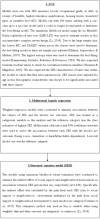Socioeconomic status, alcohol use and the role of social support and neighbourhood environment among individuals meeting criteria for a mental health problem: a cross-sectional study
- PMID: 38671188
- PMCID: PMC11522183
- DOI: 10.1007/s00127-024-02670-w
Socioeconomic status, alcohol use and the role of social support and neighbourhood environment among individuals meeting criteria for a mental health problem: a cross-sectional study
Abstract
Purpose: Indicators of socioeconomic status (SES), such as education and occupational grade, are known to be associated with alcohol use but this has not been examined among individuals with a mental health problem. This study developed latent classes of SES, their associations with alcohol use, and examined the indirect effect via social support and neighbourhood environment.
Methods: A secondary analysis of the 2014 Adult Psychiatric Morbidity Survey was conducted among participants with a mental health problem (N = 1,436). SES classes were determined using a range of indicators. Alcohol use was measured using the Alcohol Use Disorder Identification Test. Social support and neighbourhood neighbourhood environment were measured using validated questionnaires. A latent class analysis was conducted to develop SES classes. Multinomial logistic regression examined associations of SES and alcohol use. Structural equation models tested indirect effects via social support and neighbourhood environment.
Results: A four-class model of SES was best-fitting; "economically inactive,GCSE-level and lower educated,social renters", "intermediate/routine occupation,GCSE-level educated,mixed owner/renters", "retired, no formal education,homeowners", and "professional occupation,degree-level educated,homeowners". Compared to "professional occupation,degree-level educated, homeowners", SES classes were more likely to be non-drinkers; odds were highest for "economically inactive,GCSE-level and lower educated,social renters" (OR = 4.96,95%CI 3.10-7.93). "Retired, no formal education,homeowners" were less likely to be hazardous drinkers (OR = 0.35,95%CI 0.20-0.59). Associations between "economically inactive,GCSE-level and lower educated,social renters" and "retired, no formal education,homeowners" and non- and harmful drinking via social support and neighbourhood environment were significant.
Conclusions: In contrast to the alcohol harms paradox, among individuals with a mental health problem, lower SES groups were more likely to be non-drinkers while no associations with harmful drinking were found. There is also a need to examine the alcohol harms paradox in the context of the area in which they live.
Keywords: Alcohol use; Mental health; Neighbourhood environment; Social support; Socioeconomic status.
© 2024. The Author(s).
Conflict of interest statement
The authors declare that they have no conflicts of interest.
Figures


Similar articles
-
Associations between interrelated dimensions of socio-economic status, higher risk drinking and mental health in South East London: A cross-sectional study.PLoS One. 2020 Feb 14;15(2):e0229093. doi: 10.1371/journal.pone.0229093. eCollection 2020. PLoS One. 2020. PMID: 32059050 Free PMC article.
-
Associations of alcohol use, mental health and socioeconomic status in England: Findings from a representative population survey.Drug Alcohol Depend. 2021 Feb 1;219:108463. doi: 10.1016/j.drugalcdep.2020.108463. Epub 2020 Dec 30. Drug Alcohol Depend. 2021. PMID: 33421804
-
The association between neighbourhood socioeconomic status and parental mental health in the first years after birth - Cross-sectional results from the SKKIPPI project.Health Place. 2025 Jan;91:103407. doi: 10.1016/j.healthplace.2024.103407. Epub 2025 Jan 20. Health Place. 2025. PMID: 39836989
-
Neighbourhood deprivation effects on young people's mental health and well-being: A systematic review of the literature.Soc Sci Med. 2021 Feb;270:113542. doi: 10.1016/j.socscimed.2020.113542. Epub 2020 Nov 24. Soc Sci Med. 2021. PMID: 33495056
-
Areas of disadvantage: a systematic review of effects of area-level socioeconomic status on substance use outcomes.Drug Alcohol Rev. 2011 Jan;30(1):84-95. doi: 10.1111/j.1465-3362.2010.00191.x. Drug Alcohol Rev. 2011. PMID: 21219502 Free PMC article.
Cited by
-
Biopsychosocial Profile of Chronic Alcohol Users: Insights from a Cross-Sectional Study.Brain Sci. 2025 Jul 10;15(7):741. doi: 10.3390/brainsci15070741. Brain Sci. 2025. PMID: 40722332 Free PMC article.
References
-
- Nutt DJ, King LA, Phillips LD (2010) Drug harms in the UK: a multicriteria decision analysis. The Lancet 376(9752):1558–1565 - PubMed
-
- Whiteford HA, Degenhardt L, Rehm J, Baxter AJ, Ferrari AJ, Erskine HE et al (2013) Global burden of disease attributable to mental and substance use disorders: findings from the Global Burden of Disease Study 2010. The Lancet 382(9904):1575–1586 - PubMed
MeSH terms
LinkOut - more resources
Full Text Sources
Medical

